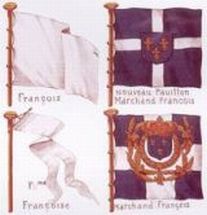
|
 |
 |
| |

APPENDIX C Flags and Uniforms

|
|
 |
| |

The White Flag As A Battle Flag ( 1 page )

|
|
 |
|
|
| |
|
| |

 |
French flags, around 1690
(Click image to enlarge)
|
Nowadays, white flags signify surrender: one side signals its desire to capitulate to the other by hoisting a piece of white cloth. But this was not always the case. At the time of New France, raising a white flag signified instead a desire to join battle.
In order to understand the reasons for this about-face, one must go back to the origins of French flags. In the Middle Ages, the kings of France displayed a blue banner decorated with three fleurs-de-lis. During the Renaissance, they added blue or red banners with a white cross in the centre. By the end of the sixteenth century, blue had gained ascendancy over red and was in general use.
During the Wars of Religion in the early seventeenth century, however, white flags without any decoration were thought to symbolize purity and became the emblem of royal might. Thereafter, regimental flags were entirely white, both the cross and the quarters, signifying that the corps belonged to the Royal Army. Royal Navy ships also began flying white pennants and flags without any fleurs-de-lis or other decorations.
In 1632, the inhabitants of the settlement at Quebec were overjoyed to see white flags floating on the masts of the French ships that had come to take possession of the colony again. We can deduce from this that white flags had probably flown in Canada in the 1620s, or even earlier, or else the inhabitants would not have recognized them as emblematic of France.
However, various other flags were also flown by both the navy and the merchant marine, since custom took precedence over regulations. In 1661, Louis XIV decided that he would end the confusion by decreeing that the white flag was henceforth the official flag of the Royal Navy and would also fly over coastal forts and in the colonies, if this were not already the case.
Archival records and illustrations show that white flags were indeed flown throughout New France. Solid white flags could be found from Acadia and Plaisance to Louisbourg, Quebec, and in numerous forts. For the colonists and French soldiers of the time, flags and pennants were "always white, because white [was] the colour of France." Their attachment to this symbol can be clearly seen in the proud response of a Canadian privateer and his men to an English invitation to switch sides: "We responded without hesitation that we were born under the white flag and would die under it."
The royal order of 1661 assigned to the merchant marine "the former flag of the French nation," i.e., blue with a white cross, to which was added a blue shield in the centre decorated with three fleur-de-lis. However, the merchant marine preferred the white flag. Large trading companies (such as the Company of the Indies) and certain ports (such as Saint-Malo) obtained special permission allowing their ships to fly this flag.
Therefore, until the adoption of the French tricolour in 1790, the plain white flag flew at all battles, but it had nothing to do with capitulation. On the contrary, it became the symbol of furious struggles, both on land and at sea. So how did the white flag come to signify surrender? It seems that when the enemies of France surrendered, they were often compelled to fly it as a sign of capitulation. After France adopted the tricolour, flying the white flag continued among all belligerents as a sign of surrender or ceasefire.
We should not overlook the white flag decorated with fleurs-de-lis, which is mentioned by so many history books as the essence of the Ancien Régime, and which often appears in encyclopedias. This beautiful flag, similar to the royal French flag with the addition of the royal coat of arms in the centre, could only be flown in the presence of the king (similar to the modern flag of the governor general of Canada). It was flown officially only very rarely in France itself, and not at all in Canada. Sometimes, Amerindian allies were given white flags decorated with the royal coats of arms, such as La Vérendrye's gift to the Mandans in December, 1738. However, these were only variations on the original. The only flag raised over the forts of New France was the white flag of France.
|
|
 |
|
|
|
 |





